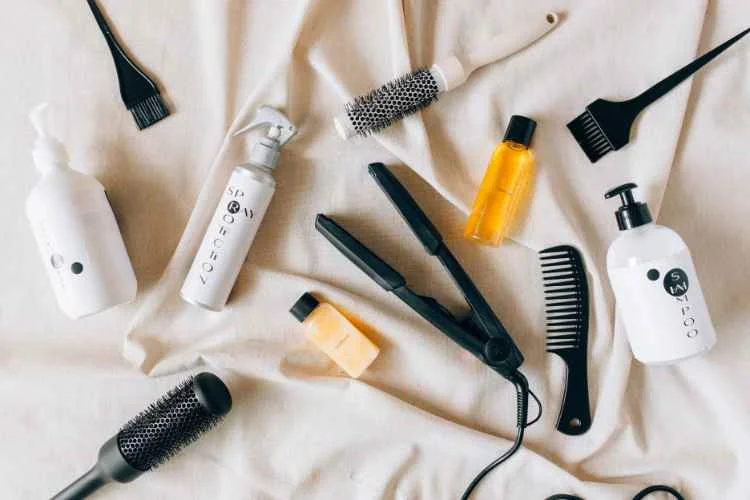In pursuing luscious locks, have you ever wondered about the hidden risks in your favorite hair products? The allure of glossy tresses often overshadows the potential dangers lingering in shampoo bottles and styling potions.
As you run your fingers through your hair, consider this: could your trusted products be concealing a silent threat? You might not realize it, but these daily grooming rituals may come with an unintended consequence that can potentially risk your health.
In this article, we will uncover the mystery behind common hair care chemicals. Also, about their possible links to cancer, aiming to empower you with knowledge for healthier choices.
Common Chemicals in Hair Products
Cancer risks in hair products require an understanding of the common chemicals found in these everyday items. Sodium lauryl sulfate (SLS) and its close cousin sodium laureth sulfate (SLES) are frequent offenders responsible for the foaming action in many shampoos. Despite their cleansing prowess, these sulfates may strip the hair of natural oils. They have also been associated with skin irritation and toxicity in organs.
Another culprit commonly found in hair products is parabens. The JES study explores their potential link to breast cancer, focusing on black women who had higher death rates from the disease. The researchers administered physiologically appropriate concentrations of parabens to West African-ancestry breast cancer cell lines.
The changes in gene expression & cell viability are seen in the results. They suggest a possible connection between parabens and the advancement of this cancer in them. It demonstrates how crucial it is to comprehend how particular chemicals affect various groups. It highlights the need for more study and education on the possible hazards of using particular personal care products.
Silicone derivatives, like dimethicone, often lend a smooth texture to conditioners and serums. While providing a glossy finish, they may create a barrier on the hair that traps in other harmful ingredients and obstructs moisture absorption.
Understanding the Link Between Chemicals and Cancer
Understanding the link between chemicals found in hair products and the potential cancer risk is a critical step toward informed consumer choices.
Research suggests these may disrupt the body’s endocrine system, potentially leading to hormonal imbalances and increased malignant risks.
Some hair products contain formaldehyde-releasing agents, known carcinogens commonly found in hair straightening treatments. Due to these concerns, there has been a surge in cases leading to the hair straightener lawsuit. According to reports, individuals have filed lawsuits claiming that certain hair straighteners contain unsafe levels of parabens, which exposes users to an increased risk of cancer.
According to TorHoerman Law, this legal action highlights the importance of scrutinizing the ingredients in these products, especially those associated with well-known styling treatments. Consumers have the right to be informed about potential health risks associated with everyday products. If someone has suffered because of them, they can seek legal recourse.
They can get compensation against damages of medical bills & expenses, impaired life quality, emotional harm, enduring disability, and additional injuries.
It underscores the significance of staying informed and advocating for transparency in the cosmetic industry. Also, understand the potential health implications of these compounds in your daily hair care routines.
Controversies and Conflicting Studies
Navigating the landscape of chemicals in hair products becomes more complex due to controversies and conflicting studies. The scientific community remains divided on the extent of the potential cancer risks associated with certain ingredients. Some studies suggest a correlation between parabens & sulfates and cancer. Others argue that the evidence is inconclusive and that more research is needed to establish a definitive link.
Conflicting findings can leave consumers uncertain about the safety of their chosen products. The lack of clear consensus among researchers adds a layer of ambiguity to an already intricate topic. It’s essential to acknowledge that the cosmetic industry continually evolves, with formulations changing over time. This dynamic nature can make it challenging to draw concrete conclusions about the long-term effects of specific chemicals.
In light of these controversies, individuals are encouraged to stay informed, critically assess research findings, and approach the subject with a balanced perspective.
Regulatory Measures and Ingredient Transparency
Amid concerns about potential cancer risks in hair products, regulatory measures and ingredient transparency play pivotal roles in safeguarding consumer health.
Regulatory agencies, such as the U.S. Food and Drug Administration (FDA), impose guidelines on cosmetic manufacturers to ensure the safety of their products. The FDA states that the firms must have records that adequately support the safety of cosmetic items. Manufacturers can utilize existing safety data, and although animal testing is not necessary, safety claims must be supported by rigorous scientific methodology.
Another regulatory act is The Modernization of Cosmetics Regulation Act, or MoCRA, which requires adherence to FDA standards. These include identifying fragrance allergens, good manufacturing practices for cosmetic facilities, and standard testing procedures for asbestos detection in talc-containing cosmetics. It emphasizes how crucial it is that businesses follow safety regulations and requirements.
Ingredient transparency is crucial for consumers to actively engage in their well-being. Some companies voluntarily disclose all ingredients, fostering an informed decision-making process. The lack of standardized labeling practices can make it challenging for consumers to decipher complex ingredient lists.
Advocacy for clearer, standardized ingredient labeling and periodic reviews of regulatory guidelines are essential steps in promoting consumer safety. Consumers can educate themselves on common harmful ingredients, seek products with transparent labeling, and support initiatives calling for stricter regulations.
Tips for Safe Hair Product Use
Begin by becoming an informed consumer. Read product labels diligently and familiarize yourself with common harmful ingredients. Opt for products that prioritize transparency and avoid those with sulfates, parabens, and other questionable chemicals. Consider exploring natural and organic alternatives, which often contain fewer synthetic additives.
Limit the frequency of chemical treatments and excessive product usage. Giving your hair breaks from styling aids can reduce exposure to potentially harmful substances. Consult dermatologists or healthcare professionals for personalized advice tailored to your specific health considerations when in doubt.
Use alternates to hair products that include artificial chemicals like sulfates and parabens, states ScienceDirect. In this regard, one can choose shampoos containing plant extracts & botanical ingredients because they are healthy, gentle, and non-toxic. These goods are also thought to maintain better standards of quality.
Consumer preferences for natural and efficient ingredients are aligned with the physical attributes and biological activities of six tropical plants. These include camellia oleifera and acacia concinna, which are frequently incorporated into such formulations. Their properties and biological activities have been scientifically accepted for their positive effects on hair care & scalp maintenance.
Implementing these tips not only prioritizes your hair’s health but also contributes to a safer and more informed approach to personal care. In a world filled with beauty choices, making conscious decisions empowers individuals to enjoy vibrant, healthy hair without compromising overall well-being.
In summary, when aiming for beautiful hair, it is essential to recognize the potential hazards associated with specific chemicals present in hair products. While scientific consensus may evolve, staying informed and adopting preventive measures is key. Read labels, choose transparent brands, and explore natural alternatives. Remember, moderation in product use and regular scalp care are simple yet impactful steps.























